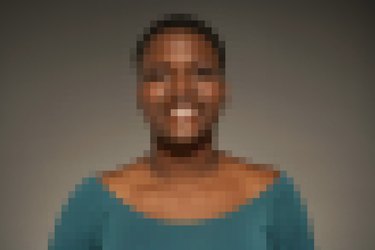
Adobe Illustrator began as a bezier drawing program with support for live text. As it gained new features, it ventured into the realm of pixel-based artwork and effects, helping you create advanced illustrations and informational business graphics. To make an object within an Illustrator document appear either made up of pixels or pixelated, you can choose from more than one way to achieve your objective, depending on whether you want to convert the object into a bitmap or just make it look like one.
Rasterize
Video of the Day
Within Adobe Illustrator's Object menu, the Rasterize option triggers a dialog box full of options for converting objects and text into pixel-based equivalents. You can convert color artwork into grayscale or black-and-white alternatives, specify the resolution for your conversion, create a white or transparent background behind colored elements, skip anti-aliasing or specify the method you want the program to use in the conversion, add a clipping mask to the resulting bitmap, build the pixel image larger than the original artwork by an amount you specify, and preserve or convert spot colors. After you apply this function, you can't restore your original vector artwork unless you undo the conversion or save your document under another name.
Video of the Day
Rasterize Effect
Adobe Illustrator's live effects support a wide range of distortions and transformations to the objects you draw, all without making destructively permanent changes to your original artwork. Among these effects, Rasterize presents you with most of the choices available in the destructive Rasterize menu item, except for the option to preserve spot colors. This effect can turn resolution-independent vector artwork or type into what looks and behaves like a pixel-based bitmap, retaining the ability to edit the conversion at any time and to remove it altogether.
Pixelation Effects
Along with the Rasterize effect, Adobe Illustrator includes four Pixelate effects grouped in a shared submenu. Color Halftone gives an object the look you see in a printed piece, on which the dot patterns applied to each color channel become visible under magnification. You specify the angle at which each screen appears and the maximum size of the dot used. Crystallize applies a cell-based appearance and enables you to specify cell size. Mezzotint mimics the look of the output and printing technique that relies on a pattern of dots, lines or strokes to make up image detail. Pointillize applies randomized dot texture that resembles the techniques used by artists who paint in that style.
Patchwork Filter
To create the look of the mosaic-like grid that makes up the pixel structure of a bitmapped image, you can use Adobe Illustrator's Patchwork filter, located in the Filter menu's Texture submenu. Patchwork fills a graphic with a pattern of three-dimensional squares, giving you control over the size of the squares and the extent to which they appear in dimensional relief. At a small square-size value and with relief set to zero, the result looks like a closeup view of pixel structure. When you enlarge the size of the squares, you can produce the look of pixelation.
Version Information
Information in this article applies to Adobe Illustrator CS6. Procedures may differ with other versions or products.